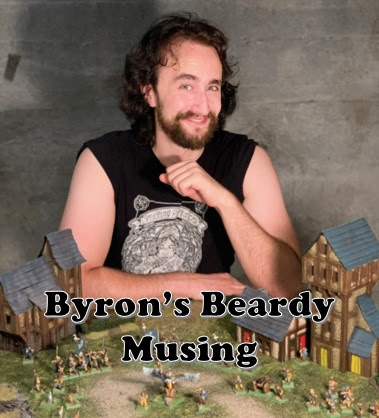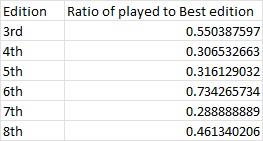 |
| Your reliable narrator delving into the more obscure Warhammer Fantasy canon |
GW is planning to re-release Warhammer Fantasy Battle. Attempting to make their entire fantasy player base happy with a single ruleset is a fool's errand.
Buckle up for the ravings and opinions (backed by DATA!) of a random dude on the internet talking obsessively about his hobby...
I am going to state my thesis from the get go:
GW will not be able to avoid criticism for its choices recreating WFB because there isn't a single target audience that just wants one single thing. Literally every choice will upset someone. They are stuck between a rock and a hard place. It cannot be done - at least not with a single game that is.
In this post I will explain why I think this is the case. Provide data to support it. And then, I will explain what I would do if somehow I magically had the power to actually choose what happened, which I don't :(
Warhammer Fantasy isn't a single unified thing. It's not like monopoly where it has effectively remained unchanged since oral traditions about the rules began (after all, who among us has actually read the rules to monopoly??). Rather, Warhammer Fantasy and the nerding community writ large, has changed substantially over time. I won't rehash the history of Warhammer or GW, that's been done. It will be sufficient instead to note that for most of us, (at least those nerdy enough to be reading this) Warhammer Fantasy is a totem of nostalgia for us; that crystalized uniquely in each of our minds at different times. Like many of our preferences in music, Warhammer "peaked" when we were developing our sense of self and identity, and suffered a heightened emotional vulnerability in highschool. And it's all (warhammer, music, society etc) been downhill ever since. Full disclosure: I first started playing warhammer with my brothers the Summer after 8th grade during the 6th edition only a few years before 7th edition came along.
Since Warhammer fantasy was ended by GW (some will say murdered by GW), most of its fans have continued to interact with the game in their own idiom. Some of us have gone on to play Age of Sigmar (I didn't), some of us kept the flame alive through the Total War series (I didn't), some of us kept playing 8th ed or moved on to 9th age or other similar fan rules (I didn't), and some of us went back to other older editions and got into the retro-content and started collecting oldhammer lead from the 80s. For each of us, that means there is this idealized kernel of what Warhammer Fantasy really is.
What Warhammer Fantasy is to you, has multifaceted implications for the type of game you would like to see GW create. This sets up staggering expectations for the game, expectations that cannot be met by a single game. Within the community there are wide ranging answers to questions such as:
Should the game be designed for tournament play? campaigns? or around cooperative/emergent storytelling?
Can you trust your opponent to be interested in you having fun and cooperating to interpret the rules, even to their disadvantage?
How streamlined or crunchy should the rules be?
How long should a game be?
How big should armies be? Skirmish games seem pretty popular right now; what barriers to entry are acceptable?
Is Warhammer high fantasy? Gritty Sword and sorcery? low fantasy? What's the right vibe?
Which miniature style is best? hand sculpted with greenstuff? 90's monopose? multipart kits? computer sculpted kits? metal? plastic? resin?
Where does Warhammer fit on the war simulation to abstract game spectrum? I.E. is it "just a game" or is it trying to realistically represent war (y'know, realistic but with Wizards and dragons and such)?
And then there is the baggage that some of us bring from other traditions such as:
Should play proceed I go you go, or borrow from other activation mechanics like form Bolt Action, Lion Rampant, or the Game of Thrones board game
Should Warhammer fantasy rules parallel or borrow from 40k?
Should Warhammer's mechanics borrow from the decade of game development since its demise or should it be an eternal Karak weathering the storms of time and fleeting preferences and fads?
To help answer this question of what GW ought to do, I conducted a poll. I received 584 responses (number of answers vary by question). The poll was extensive. Questions covered player's experience with various games, aesthetics, particular rules questions, army composition, model count, whether their should be army books, etc.
Many of the answers to this survey would be completely useless to someone trying to make a single set of warhammer rules. Take, for example, whether you may march to within 8" of the enemy. 51.2% of those surveyed said you should be able to march to within 8" of the enemy. While 48.8% said that marchers should stop marching 8" from the enemy. From a rule-writing standpoint, picking either choice will upset (or, if we are being less hyperbolic, mildly irk) the other half.
As an aside, the survey results also suggest that my personal perspective on what warhammer should be is also not reflective of the majority of players. So I will be doing my best to set aside what I want Warhammer to be and speak to what it seems the player base is actually champing for.
So, who is the old player base? (that is, the survey presumes anyone participating has experience with the old games)
The largest touchstone for the community was Warhammer 6th edition, followed by those who had also played Warhammer 40k. This raises some interesting points immediately, first we always have to be cognizant of the crosspollination between fantasy and 40k players. Second, we have to consider whether a rule is "good" or not, or whether fans will respond well to it based on their experiences. For example many of the rules questions in the survey include rules from 3rd edition. As we can see 3rd edition is very underrepresented in the data; does this mean that when rules from 3rd edition have low preferences in polling questions that players don't like the rule or that they aren't familiar with it? It raises the question whether answers to questions should be controlled for whether players played a given edition, or if we need to model the rules after what the majority is after.
Next, which edition is regarded as best? (here, those surveyed could provide multiple answers)
The clear winner is 6th edition. Lagging substantially in 2nd place is 8th edition, and to note, 7th edition with 6th ed army books comes in 3rd before 7th edition. This really tells us something about 7th edition. Remember, there is no "vote stealing" here. Survey participants could select as many "best editions" as they wanted so ravening hordes did not "steal votes" from 6th editions.
Now, here is where the data gets interesting, if we control the data from the second question with the first one, that is, we are now asking, among people who actually played a given edition, what percentage of them said it was the best edition? Here we get similar but interesting results.
So what's the answer? 3 different rulesets
Tournament Rules
- Chariots as a single model
- the 8th edition rules for buildings
- No lap around
- Treating war machines as a single model with point and scatter rules
- Free measuring rules
- No armor encumbrance and minimal weapon modifiers (e.g. no initiative modifers)
- Simplified charging and maneuver rules
- When rolling to wound a 6 always wounds
- Chargers attack first
- Poison simplified to a 6 on the to-hit roll
- being able to march within 8" of the enemy.
- magic should be volatile and potent, and as equally decisive as close combat and ranged weapons
- Re-rolls and command points systems would likely be borrowed from 40k to reduce volatility
Oldhammer Rules
- armor encumbrance
- command and control
- Ld tests to maneuver units
- skirmishers being afraid of blocks of troops
- emphasis on psychology
- heroes and monsters with relatively muted stats (think characters from warhammer historical)
- no single rule for poison, but a case by case rule for each type
- lap around and free hacks
- Each big monster having attack charts like giants
- push back and rules for being unformed
- Retreat in good order and unit formations
- shield walls, pike phalanxes that stop cavalry
- more specific gear options
- chariots and war machines as multiple models with separate stat lines
- Magic should be small scale and a minor force
- baggage trains
The Intro Game
- Imperial grave robbers/explorers in Khemri in the style of Heroquest or Space Hulk
- Bretonnian Peasants with torches hunting (or being hunted by) the local forest monster as a grim dark hidden movement game
- A game of apprentice wizards and their familiars battling in a library
- Orc and Goblin pirates vs Undead pirates
- Realm of Chaos - a campaign skirmish game of gaining favor from the gods of Chaos - snap fit models with sprues of mutations that could be popped in and out to keep up with the mutations could be fun
- Hellpit - a bleak gladiatorial combat game set in the Skaven city of Hellpit, where players are made to fight each other and grotesque skaven abominations
- Maybe a call back to Battle Cars and Ben Hurr with a chariot race game
- Estallian explorers and looters in the New World trying to survive and make it back to their ship or get through a temple complex
- Assassins - a all vs 1 game where one player takes on the role of the assassin in a hidden movement game trying to kill a dignitary
- Snotlings fighting over a dungheap
- night goblins, dwarves, and Skaven tunneling teams - with a card deck of tunnel sections so the players can dig tunnels to try and get at eachother's loot
- Maybe a Conan the Barbarian-like small battle game set in the time of Sigmar
- A Clue/221 B Baker Street crossover with Warhammer minis collecting clues and brawling in the streets of a town or across a old world landscape
Conclusion
If you disagree or would like to offer any addendums please feel free to hash it out in the comments below.


I like the idea of a separate set of tournament rules. A lot of tournaments use “Comp Packs” which attempt to deal with balance issues whilst encouraging players to take more rounded Army Lists.
ReplyDeleteI’d rather see a change to the “I go you go” activation system. I would have liked to see results from a survey on that subject.
I really enjoyed reading this - and I like the thought-hole you fell into with it. It'd be interesting to survey preferred edition with age - as I suspect (as you mentioned) that preference can tie closely to coming of age. For me I relate to the game of 6th, but am lured to the flavour or 3rd. The idea of a rule-lite and a rule-heavy is smart, and something I can relate to Mordheim with stacks of fan rules adding so much flavour - however I do like the idea of a rule-superheavy version, which could be really exciting.
ReplyDeleteCampaign systems are another facet worth exploring - which can largely sit parallel to in game rules, but I like the idea of those interconnecting.
This was a terrific read both when you posted it, and now a year later when Old World is out and shaking everyone's hands. Have you had time/exposure to compare and contrast your predictions, your hopes, and the resultant game?
ReplyDelete